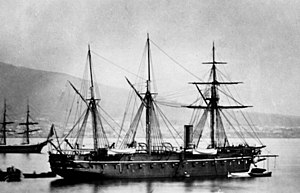
Affondatore was an armoured ram of the Regia Marina, built in the 1860s by Harrison, Millwall, London. Construction commenced in 1863; the ship, despite being incomplete, was brought to Italy during the Third Italian War of Independence. Affondatore, which translates as "Sinker", was initially designed to rely on her ram as her only weapon, but during construction she was also equipped with two 300-pounder guns.

Palestro was an ironclad warship, the second and final member of the Principe Amedeo class, built for the Italian Regia Marina in the 1860s and 1870s. She was armed with a battery of six 254 mm (10 in) guns and one 279 mm (11 in) gun. The last sail-rigged ironclad of the Italian fleet, she had a single steam engine that was capable of propelling the ship at a speed of slightly over 12 knots.

The Principe Amedeo class was a pair of ironclad warships built for the Italian Regia Marina in the 1870s and 1880s. They were the culmination of a major naval construction program designed to give Italy a powerful fleet of ironclads. The two ships, Principe Amedeo and Palestro, were the last Italian ironclads to feature sailing rigs and wooden hulls. They were armed with a battery of six 254 mm (10 in) guns and were capable of a speed in excess of 12 knots. The ships had uneventful careers, spending much of it in Italy's colonial empire. By the late 1880s, they were withdrawn from service and employed in secondary roles, first as headquarters ships for harbor defenses. Principe Amedeo was converted into a depot ship in 1895 and was discarded in 1910, while Palestro was used as a training ship from 1894 to 1900 before being scrapped between 1902 and 1904.

Roma was an ironclad warship built for the Italian Regia Marina in the 1860s; she was the lead ship of the Roma-class ironclads. Armed with a main battery of five 254 mm (10 in) and twelve 203 mm (8 in) guns in a broadside arrangement, Roma was obsolescent by the time she entered service. As a result, her career was limited. In 1880, she took part in an international naval demonstration off Ragusa to enforce the Treaty of Berlin. In November 1881, she collided with the ironclad Principe Amedeo in a storm in Naples, but she was not damaged. Roma was reduced to a guard ship in 1890 and then to a depot ship in 1895. In July 1896, she was scuttled to save the ship from a fire caused by a lightning strike. She was thereafter raised and broken up for scrap.

Venezia was the second of two Roma-class ironclad warships built for the Italian Regia Marina in the 1860s. She was armed with a main battery of eighteen 254 mm (10 in) guns in a central armored casemate. Her lengthy construction time, a result of her re-design from a broadside ironclad, quickly rendered her obsolescent compared to the new turret ships that began to enter service in the 1880s. As a result, her career was limited. She became a training ship in 1881 and served until 1895. Venezia was broken up for scrap the next year.
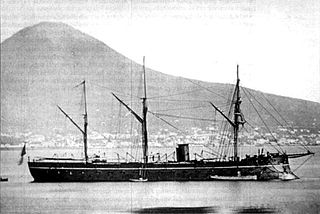
Regina Maria Pia was the lead ship of the Regina Maria Pia class of ironclad warships built in French shipyards for the Italian Regia Marina in the 1860s. She and her three sister ships were broadside ironclads, mounting a battery of four 203 mm (8 in) and twenty-two 164 mm (6.5 in) guns on the broadside. Regina Maria Pia was laid down in July 1862, was launched in April 1863, and was completed in April 1864.

San Martino was a Regina Maria Pia-class ironclad warship, the second member of her class. She was built for the Italian Regia Marina in the 1860s; like her three sister ships, she was built in France. San Martino was laid down in July 1862, was launched in September 1863, and was completed in November 1864. The ships were broadside ironclads, mounting a battery of four 203 mm (8 in) and twenty-two 164 mm (6.5 in) guns on the broadside.

Castelfidardo was the third of four Regina Maria Pia-class ironclad warships built in French shipyards for the Italian Regia Marina in the 1860s. Castelfidardo was laid down in July 1862, was launched in August 1863, and was completed in May 1864. She and her three sister ships were broadside ironclads, mounting a battery of four 203 mm (8 in) and twenty-two 164 mm (6.5 in) guns on the broadside.
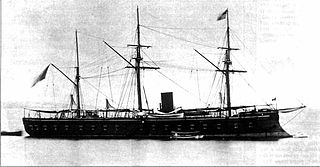
Ancona was an ironclad warship, the last member of the Regina Maria Pia class built in French shipyards for the Italian Regia Marina in the 1860s. Ancona was laid down in August 1862, was launched in October 1864, and completed in April 1866. She and her three sister ships were broadside ironclads, mounting a battery of four 203 mm (8 in) and twenty-two 164 mm (6.5 in) guns on the broadside.
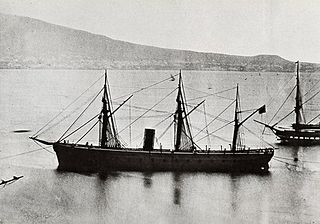
Re di Portogallo was an ironclad warship built for the Italian Regia Marina in the 1860s, the second and final member of the Re d'Italia class. She was laid down at the William H. Webb Shipyard in New York in December 1861, was launched in August 1863, and was completed a year later in August 1864; the two Re d'Italia-class ships were the only Italian ironclads built in the United States. The ships were broadside ironclads, armed with a battery of six 72-pounder guns and thirty-two 164 mm (6.5 in) guns.
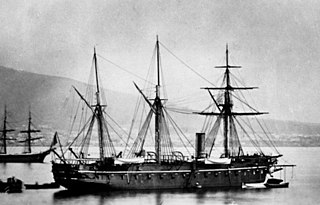
Principe di Carignano was the lead ship of the Principe di Carignano class of ironclad warships built for the Italian Regia Marina in the 1860s. She was the first ironclad built in Italy; her keel was laid January 1861, her hull was launched in September 1863, and she was completed in June 1865. Principe di Carignano was a broadside ironclad armed with a battery of ten 203 mm (8 in) guns and twelve 164 mm (6.5 in) guns.

Conte Verde was the third of three Principe di Carignano-class ironclads built for the Italian Regia Marina, though she differed in several respects from her sisters. Unlike the other two members of her class, she did not receive complete iron armor, instead relying on partial plating at her bow and stern. She was laid down in February 1863, she was launched in July 1867, and she was completed in December 1871. Conte Verde was a broadside ironclad armed with a battery of four 203 mm (8 in) guns and eighteen 164 mm (6.5 in) guns. Her career was limited, owing to the emergence of more modern ironclads and a severe reduction in the Italian naval budget following their defeat at the Battle of Lissa in 1866. She was discarded in 1880 and sold to ship breakers to help pay for new ironclads then under construction.

Terribile was the first ironclad warship to be built for the Italian Regia Marina, and the second member of the Formidabile class. Terribile and her sister, Formidabile, were both built in France. A broadside ironclad, she was laid down in June 1860, launched in February 1861, and was completed in September that year. She was the first Italian ironclad to enter service and was equipped with four 203 mm (8 in) and sixteen 164 mm (6.5 in) guns.
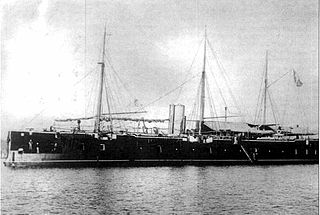
Formidabile was the lead ship of the Formidabile-class ironclad warships, the first ships of that type to be built for the newly formed Italian Regia Marina. Formidabile and her sister, Terribile, were both built in France; Formidabile was laid down in December 1860, was launched in October 1861, and was completed in May 1862. She was a broadside ironclad, equipped with four 203 mm (8 in) and sixteen 164 mm (6.5 in) guns.

The Roma class was a pair of ironclad warships built for the Italian Regia Marina in the 1860s and 1870s. The class comprised two ships, Roma and Venezia. Roma was a broadside ironclad armed with five 254 mm (10 in) and twelve 203 mm (8 in) guns, while Venezia was converted into a central battery ship during construction, armed with a much more powerful battery of eighteen 10-inch guns. Neither ship had an eventful career, due in large part to their rapid shift to obsolescence. Venezia and Roma were withdrawn from service for auxiliary duties in 1880 and 1890, respectively. Both were stricken from the naval register in 1895 and broken up for scrap the following year, Roma having been badly damaged in a fire in 1895.

The Regina Maria Pia class was a group of four ironclad warships built for the Italian Regia Marina in the 1860s. The class comprised four ships, Regina Maria Pia, San Martino, Castelfidardo, and Ancona. They were built by French shipyards, since Italian yards were unable to meet the demand of the rapidly expanding Italian fleet. The ships were broadside ironclads and mounted a battery of twenty-six muzzle loading guns.

The Re d'Italia class was a pair of ironclad warships built for the Italian Regia Marina in the 1860s. The class comprised two ships, Re d'Italia and Re di Portogallo. The two ships were built in the United States, and were based on the French ironclad Gloire; they were armed with a battery of thirty-eight guns in a broadside arrangement and were protected with 120 mm (4.7 in) of wrought iron plating.

The Principe di Carignano class was a group of three ironclad warships built for the Italian Regia Marina in the 1860s. The class comprised the ships Principe di Carignano, Messina, and Conte Verde. Originally ordered as wooden frigates, they were the first ironclads to be built in Italy, but the inexperience of the Italian shipyards and the redesign process produced lengthy construction times, such that only the lead ship was completed in time to see action during the Third Italian War of Independence in 1866. The first two ships were protected by a complete belt of wrought iron plating that was 121 mm (4.75 in) thick, while Conte Verde only received a partial iron belt.

The Formidabile class was a pair of ironclad warships built for the Italian Regia Marina in the 1860s. The class comprised two ships, Formidabile and Terribile. Initially ordered for the Regia Marina Sarda, by the time they were completed the Kingdom of Sardinia had unified the rest of the Italian states and created the Regia Marina. They were the first ironclads built for the Italian fleet. Wooden-hulled vessels plated with 4.3 inches (109 mm) of wrought iron, they were armed with a battery of twenty guns in a broadside arrangement.
